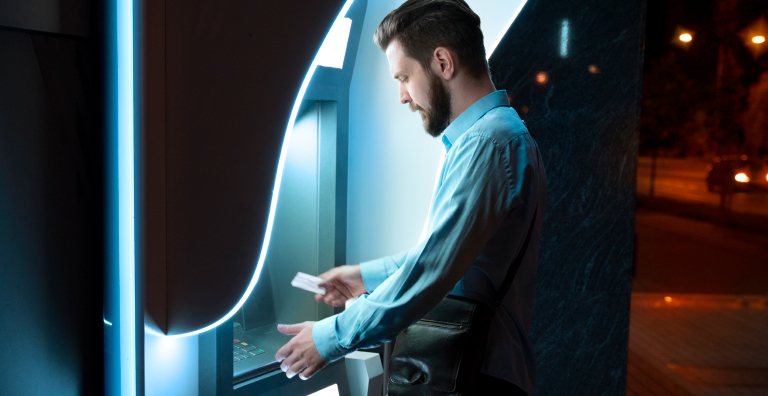Improving the ATM and Banking Experience With Biometric Multi-Factor Authentication
The Challenges of ATM Authentication
Consumers have trusted ATMs to meet their banking needs. However, lately, there has been an increase in the rate of ATM fraud worldwide. A recent study by CreditUnion Times said that 86% of respondents had experienced ATM data fraud in the previous year. We live in a digital era where hackers can use social engineering techniques to get critical banking information. Typically, most ATMs validate a user by verifying their cards and personal identification numbers, which can be easily lost, stolen or skimmed, thus leaving ATMs prone to fraudulent attacks. While the traditional approach confirms what the user has (card) and what they know (PIN), there's a need to create a system that verifies that the user truly is who they say they are.
The only solution that can ultimately authenticate and verify a user's true identity is biometrics.
Balancing Convenience and Security
Biometric technology gives financial institutions a means to verify and authenticate customers to access services quickly and safely, whether they be at the branch, ATM, online or accessing banking services via mobile apps.
Biometrics are more convenient than traditional authentication methods since bank customers must no longer carry bank cards or government-issued IDs or recall their personal identification numbers or account numbers. They can access banking services with a glance of their face and/or a touch of a button to verify their identity.
The Importance of Biometric Multi-Factor Authentication
Multi-factor authentication is a security method that requires more than one form of authentication to confirm a user’s identity. The technology aims to identify what the user knows (password/PIN), what the user has (card/phone) and who the user is (biometric verification).
Biometric multi-factor authentication is when a banking application includes both fingerprint and facial recognition, for instance, to authenticate the user. Therefore, biometric multi-factor authentication is quickly becoming the de facto standard for secure identification and transactions because it offers the security AND convenience needed to create a seamless ATM and banking experience. Incorporating facial recognition as the first factor of authentication allows ATMs, teller applications, online banking apps and more to confirm the customer’s identity and load their account information without the need for inserting a card, entering a PIN or password, or taking out their government ID, checkbook or any other type of information required to access an ATM or banking service. Once the customer lays their finger on the fingerprint reader, the second factor authentication is performed, not only validating the exact presence of the individual accessing the ATM or banking service, but also verifying the intent to complete the transaction. Simply put, biometric multi-factor authentication enables the customer to experience an ultra-convenient way to access an ATM or banking service, while simultaneously increasing security, efficiency and compliance for the banking institution!
Four Tips to Ensure Successful Biometric Implementation
Whether you decide to use facial and/or fingerprint biometrics, you should adopt specific practices to ensure your new system is secure, convenient and reliable. Here are a few factors to consider:
- Sensor reliability — Biometric sensors such as cameras and fingerprint readers must be ensured to work under real-world circumstances. Technologies like multispectral imaging (MSI) from HID Global ensure the highest protection against spoofing schemes, regardless of environmental factors, including lighting anomalies from complete darkness to flooding light, temperature, dirt, oil, dry or calloused hands and makeup.
- Liveness detection — One of the most common challenges facing standard biometric solutions is the presentation attack. Fraudsters can use high-definition photos, face masks or fake fingerprints to access a customer's accounts. Utilizing certified advanced presentation attack detection avoids these types of fraudulent activities.
- Knowing your customers and safeguarding their privacy — For ease of operation, banks need to understand their customers and make an effort to protect their privacy. HID Global’s biometric authentication technology lets you anchor each customer with a unique and random trusted identity stored in an encrypted database, requiring secure communications with all systems within your secure banking platform to safeguard valuable customer data and information from third parties.
- Making sure your system is tamper-resistant — Every new data breach serves as a reminder that all user data is valuable and private. A biometric sensor must therefore be a tamper-resistant and secure edge device able to connect to a financial institution’s systems through a cryptographically secured channel. Device authentication and secure encryption of data at rest as well as in transit between the biometric device and the institution’s IT systems where data is stored, ensure that customer data and financial transactions are conducted over a truly secure connection.
The Ultimate Solution for Security and a Positive Customer Experience
With biometric security, your customers won’t have to do anything more than simply be who they are to access banking services. Biometric security offers convenience, ease and efficiency in ways that traditional forms of security do not, leading to a paramount customer experience. Read this eBook to learn more: Improving the ATM Experience With Biometrics Multi-Factor Authentication.
Todd Seeley is an Applications and Integration Manager, specializing in breakthrough technologies at HID Global Corporation. He has a background in regulatory compliance, engineering and finance and has spent the last 14 years focusing on innovative biometric and digital identity solutions for real-world applications.
